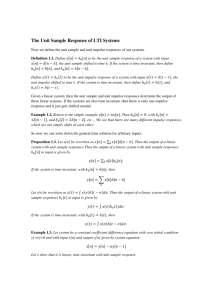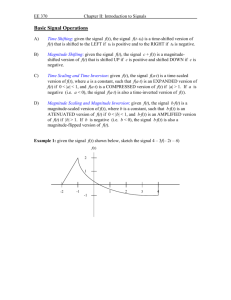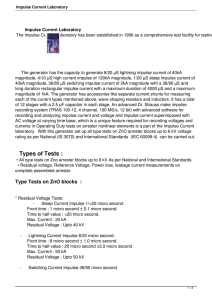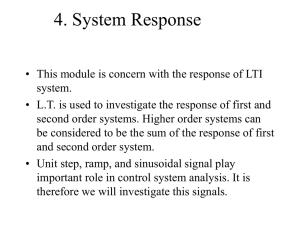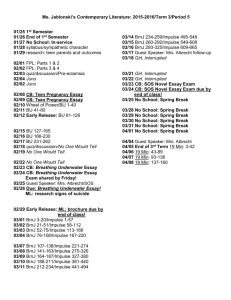Canonical_Response
advertisement
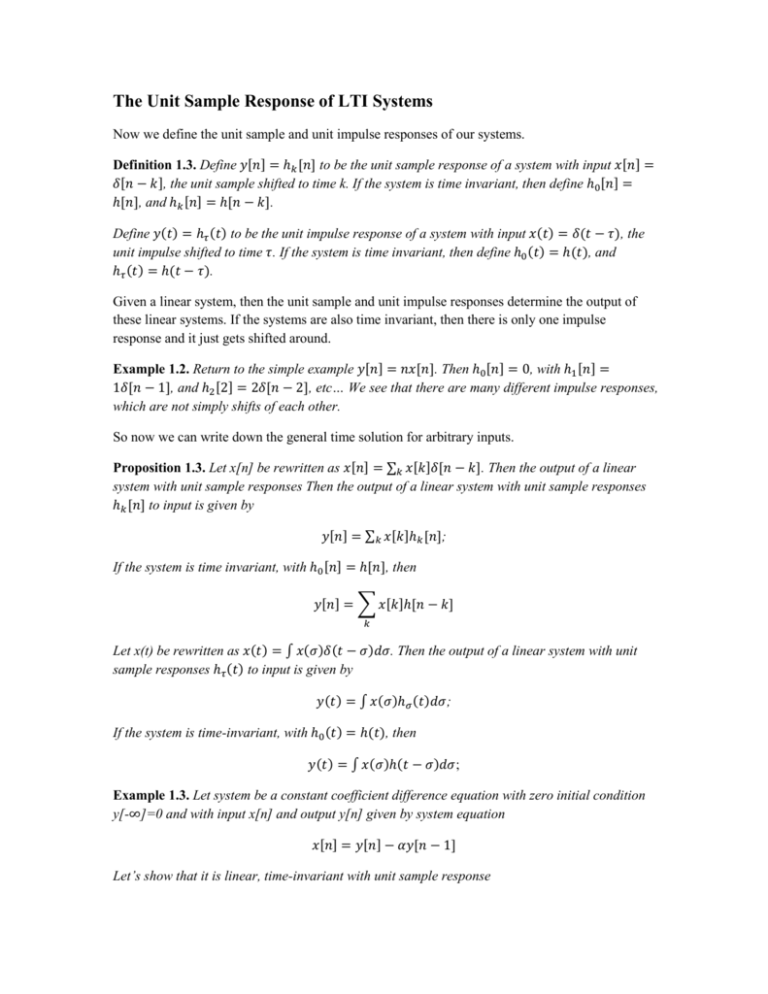
The Unit Sample Response of LTI Systems Now we define the unit sample and unit impulse responses of our systems. Definition 1.3. Define 𝑦[𝑛] = ℎ𝑘 [𝑛] to be the unit sample response of a system with input 𝑥[𝑛] = 𝛿[𝑛 − 𝑘], the unit sample shifted to time k. If the system is time invariant, then define ℎ0 [𝑛] = ℎ[𝑛], and ℎ𝑘 [𝑛] = ℎ[𝑛 − 𝑘]. Define 𝑦(𝑡) = ℎ𝜏 (𝑡) to be the unit impulse response of a system with input 𝑥(𝑡) = 𝛿(𝑡 − 𝜏), the unit impulse shifted to time 𝜏. If the system is time invariant, then define ℎ0 (𝑡) = ℎ(𝑡), and ℎ𝜏 (𝑡) = ℎ(𝑡 − 𝜏). Given a linear system, then the unit sample and unit impulse responses determine the output of these linear systems. If the systems are also time invariant, then there is only one impulse response and it just gets shifted around. Example 1.2. Return to the simple example 𝑦[𝑛] = 𝑛𝑥[𝑛]. Then ℎ0 [𝑛] = 0, with ℎ1 [𝑛] = 1𝛿[𝑛 − 1], and ℎ2 [2] = 2𝛿[𝑛 − 2], etc… We see that there are many different impulse responses, which are not simply shifts of each other. So now we can write down the general time solution for arbitrary inputs. Proposition 1.3. Let x[n] be rewritten as 𝑥[𝑛] = ∑𝑘 𝑥[𝑘]𝛿[𝑛 − 𝑘]. Then the output of a linear system with unit sample responses Then the output of a linear system with unit sample responses ℎ𝑘 [𝑛] to input is given by 𝑦[𝑛] = ∑𝑘 𝑥[𝑘]ℎ𝑘 [𝑛]; If the system is time invariant, with ℎ0 [𝑛] = ℎ[𝑛], then 𝑦[𝑛] = ∑ 𝑥[𝑘]ℎ[𝑛 − 𝑘] 𝑘 Let x(t) be rewritten as 𝑥(𝑡) = ∫ 𝑥(𝜎)𝛿(𝑡 − 𝜎)𝑑𝜎. Then the output of a linear system with unit sample responses ℎ𝜏 (𝑡) to input is given by 𝑦(𝑡) = ∫ 𝑥(𝜎)ℎ𝜎 (𝑡)𝑑𝜎; If the system is time-invariant, with ℎ0 (𝑡) = ℎ(𝑡), then 𝑦(𝑡) = ∫ 𝑥(𝜎)ℎ(𝑡 − 𝜎)𝑑𝜎; Example 1.3. Let system be a constant coefficient difference equation with zero initial condition y[-∞]=0 and with input x[n] and output y[n] given by system equation 𝑥[𝑛] = 𝑦[𝑛] − 𝛼𝑦[𝑛 − 1] Let’s show that it is linear, time-invariant with unit sample response ℎ[𝑛] = 𝛼 𝑛 𝑢[𝑛] Linearity: Let 𝑥1 [𝑛] give 𝑦1 [𝑛], and 𝑥2 [𝑛] give 𝑦2 [𝑛], then we have 𝑎𝑥1 [𝑛] + 𝑏𝑥2 [𝑛] = 𝑎𝑦1 [𝑛] − 𝑎𝛼𝑦1 [𝑛 − 1] + 𝑏𝑦2 [𝑛] − 𝑏𝛼𝑦2 [𝑛 − 1] = (𝑎𝑦1 [𝑛] + 𝑏𝑦2 [𝑛]) − 𝛼(𝑎𝑦1 [𝑛 − 1] + 𝑏𝑦2 [𝑛 − 1]) Time invariant: Introduce shift 𝑚0 according to 𝑥[𝑚 − 𝑚0 ] = 𝑦[𝑚 − 𝑚0 ] − 𝛼𝑦[𝑚 − 𝑚0 − 1] Let 𝑛 = 𝑚 − 𝑚0 , then for any 𝑚0 we have 𝑥[𝑛] = 𝑦[𝑛] − 𝛼𝑦[𝑛 − 1] 𝑥[𝑚 − 𝑚0 ] = 𝑦[𝑚 − 𝑚0 ] − 𝛼𝑦[𝑚 − 𝑚0 − 1] Implying 𝑥[𝑛 − 𝑚0 ] = 𝑦[𝑛 − 𝑚0 ] − 𝛼𝑦[𝑛 − 𝑚0 − 1] To solve for the unit-sample response, let 𝛿[𝑛] = ℎ[𝑛] − 𝛼ℎ[𝑛 − 1] Then ℎ[𝑛] = 0, 𝑛 ≤ −1, then ℎ[0] = 𝛿[0] = 1 ℎ[1] = 𝛼ℎ[0] = 𝛼 ℎ[2] = 𝛼ℎ[1] = 𝛼 2 ℎ[𝑛] = 𝛼 𝑛 , 𝑛 ≥ 0 Notice, complex exponentials pass right through this system as well with just a complex number added, guess 𝑦[𝑛] = 𝐻𝑒 𝑖𝜔𝑛 , then 𝑒 𝑖𝜔𝑛 = 𝐻𝑒 𝑖𝜔𝑛 − 𝛼𝐻𝑒 𝑖𝜔(𝑛−1) Implying 𝐻= 1 1 − 𝛼𝑒 −𝑖𝜔 Example 1.4. Let us return to our favorite differential equation: 𝑥(𝑡) = 𝑦̇ (𝑡) + 𝛼𝑦(𝑡), 𝑦(−∞) = 0, with impulse response ℎ(𝑡) = 𝑒 −𝛼𝑡 𝑢(𝑡) To see this, let us solve the differential equation for the impulse response: 𝛿(𝑡) = ℎ̇(𝑡) + 𝛼ℎ(𝑡), ℎ(−∞) = 0 Use the face that ℎ̇(𝑡) = 𝛿(𝑡), implying for t < 0, then h(t)=0. For 𝑡 ≥ 0, then if ℎ(𝑡) = 𝑒 −𝛼𝑡 𝑢(𝑡), we have 𝛿(𝑡) = 𝑑 𝑑 𝑢(𝑡) = 𝑒 −𝛼𝑡 𝑢(𝑡) + 𝛼𝑒 −𝛼𝑡 𝑢(𝑡) 𝑑𝑡 𝑑𝑡 = 𝑒 −𝛼𝑡 𝑑 𝑢(𝑡) − 𝛼𝑒 −𝛼𝑡 𝑢(𝑡) + 𝛼𝑒 −𝛼𝑡 𝑢(𝑡) 𝑑𝑡 At t < 0, 0=0, and t > 0 0 = −𝛼𝑒 −𝛼𝑡 𝑢(𝑡) + 𝛼𝑒 −𝛼𝑡 𝑢(𝑡) t=0 𝑑 𝑢(𝑡) 𝑑𝑡 = 𝑑 𝑢(𝑡) 𝑑𝑡 − 𝛼𝑒 −𝛼𝑡 𝑢(𝑡) + 𝛼𝑒 −𝛼𝑡 𝑢(𝑡) So now we have our general solutions for the difference equations and differential equations. For the difference equation 𝑥[𝑛] = 𝑦[𝑛] − 𝛼𝑦[𝑛 − 1] We have 𝑦[𝑛] = 𝑥[𝑛] ∗∗ ℎ[𝑛] = ∑ 𝑥[𝑘]ℎ[𝑛 − 𝑘] 𝑘=−∞ ∞ = ∑ 𝑥[𝑘]𝛼 𝑛−𝑘 𝑢[𝑛 − 𝑘] 𝑘=−∞ ∞ = ∑ 𝑥[𝑘]𝛼 𝑛−𝑘 𝑘=−∞ For an input of 𝑥[𝑛] = 𝑢[𝑛], then we have 𝑛 𝑛 𝑦[𝑛] = ∑ 𝑢[𝑘]𝛼 𝑘=−∞ 𝑛−𝑘 = ∑ 𝛼 𝑛−𝑘 𝑢[𝑛] 𝑘=−∞ 1 − 𝛼 −(𝑛+1) =𝛼 𝑢[𝑛] 1 − 𝛼 −1 𝑛 = 𝛼 𝑛+1 − 1 1 − 𝛼 𝑛+1 𝑢[𝑛] = 𝑢[𝑛] 𝛼−1 1−𝛼 For the differential equation 𝑥(𝑡) = 𝑦̇ (𝑡) + 𝛼𝑦(𝑡) We have ∞ 𝑦(𝑡) = 𝑥(𝑡) ∗∗ ℎ(𝑡) = ∫ 𝑥(𝜎)𝑒 −𝛼(𝑡−𝜎) 𝑢(𝑡 − 𝜎)𝑑𝜎 −∞ 𝑡 = ∫ 𝑥(𝜎)𝑒 −𝛼(𝑡−𝜎) 𝑑𝜎 −∞ For x(t)=u(t), then 𝑡 𝑦(𝑡) = ∫ 𝑒 −𝛼(𝑡−𝜎) 𝑑𝜎𝑢(𝑡) = 𝑒 −𝛼𝑡 0 1 𝛼𝜎 𝑡 1 𝑒 | 𝑢(𝑡) = (1 − 𝑒 −𝛼𝑡 )𝑢(𝑡) 𝛼 0 𝛼 Example 1.5. Examine an RLC circuit, take the output across the capacitor. Then y(t) is taken as the output with input the voltage source x(t). To derive the input-output relationship, let’s use one of the two stalwarts of circuit theory – Kirchoffs voltage law. The voltage across the capacitor output y(t) when added to the voltage across the resistor must add to the input voltage x(t). The voltage across the resistor is RI(t). I, the derivative of the current is given by 𝐶𝑦̇ (𝑡). Thus, we have the equation 𝑥(𝑡) = 𝑅𝐶𝑦̇ (𝑡) + 𝑦(𝑡), 𝑦(−∞) = 0 Notice the initial condition corresponds to no voltage across the capacitor – system at rest. We have our LTI system (first-order constant-coefficient differential equation), with impulse 1 1 response ℎ(𝑡) = 𝑅𝐶 𝑒 −𝑅𝐶𝑡 𝑢(𝑡). The output becomes 𝑦(𝑡) = ∫ 𝑥(𝜎) = 1 𝑡−𝜎 𝑒 𝑅𝐶 𝑢(𝑡 − 𝜎)𝑑𝜎 𝑅𝐶 𝑡−𝜎 1 𝑡 ∫ 𝑥(𝜎)𝑒 𝑅𝐶 𝑑𝜎 𝑅𝐶 −∞
